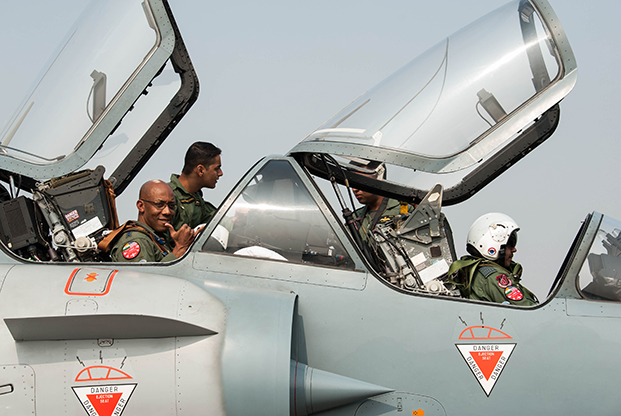
PACAF Commander Gen. Charles Q. Brown Jr., left, prepares for an orientation flight in an Indian Air Force Mirage 2000, during Cope India 2019. Photo: SSgt. Hailey Haux
When then-Defense Secretary Jim Mattis announced in May that US Pacific Command’s name was changing to US Indo-Pacific Command, he noted the change was made “in recognition of the increasing connectivity between the Indian and Pacific oceans.”
With an area of responsibility stretching from Bollywood to Hollywood, INDOPACOM commanders see the name change as recognition of a changing world in which India figures as a more significant force. The US and India have been building their defense partnership since 2005, when the two nations signed the New Framework for the US-India Defense Relationship. But there’s more changing now than just the name of a command.
“As democracies bookending the Indo-Pacific region, the United States and India share an interest in advancing security and prosperity in the region and the world,” said USAF Capt. Victoria Hight, a PACAF spokeswoman. During the Cope India exercise in December, she said, USAF airmen got a chance to put that to the test and “expand engagements with our Indian air force partners and showcase the US and India’s efforts and commitment to a free and open Indo-Pacific.”
Previously held in 2004, 2005, and 2009, the 2018 edition of the exercise marked the first time Cope India was at two separate operating locations. It included 200 USAF airmen, xand F-15s from Kadena AB, Japan, and C-130Js from the Illinois Air National Guard, as well as Indian Air Force Sukhoi Su-30s, Jaguars, Mirage 2000s, and C-130Js.
Lt. Col. John DeLion, commander of the 67th Fighter Squadron, was among 145 airmen from Kadena who traveled to India for the exercise.
“It was amazing,” he said. “The dinners they hosted for us, how they helped us overcome some logistics problems, backing us up, it was just fantastic.”
“Obviously we have a lot in common,” DeLion said. The two nations are “the world’s oldest continually running democracy and the world’s largest democracy,” he said, so it’s a “great opportunity for working on our interoperability.”
The exercise afforded more than the usual opportunities for interaction, he explained, describing “driven interaction” designed to increase interplay between the two air forces. Airmen had more time to get out to the flight line to see the jets and sit in the cockpits, for example, and to compare notes on maintenance procedures.
Indian maintainers impressed their American counterparts with how resourceful and flexible they can be. “We used tractors, like actual Farmer John tractors, to move around equipment,” said SSgt. Richard Bishop, an F-15 crew chief with the 67th Aircraft Maintenance Unit. Previously, “we never would think that was a viable option.”
US airmen also worked with Indian airmen to put up a barrier for arresting jets in case of in-flight emergencies. A job that normally takes a week was done in half the time because the cooperative IAF shut down what was needed, Bishop said, and just “let us work.”
Using a “building-block approach,” the exercise began with smaller sorties and gradually grew until, over the last few days, the two air forces were combining for large force exercises, DeLion said. The focus was on interoperability, but not just in the air, he stressed.
“I would say it’s much more encompassing than can we fight or train together—it’s can we do everything together,” he said.
CMSgt. Spencer Ridgway, superintendent of the 67th Aircraft Maintenance Unit, called the high level of interaction between the two air forces “awesome,” an opportunity to better understand how the two are alike and how they are different. Differences were “as simple as how do we sign out tools? How do we store them? Or what’s our procedure before we let a jet fly on tool control?” he said. In India, for example, the pilot has to inspect the tool room and certify that all the tools are there before the jet can be declared airworthy. By contrast, USAF trusts airmen to do tool inventory as part of the daily maintenance routine.
For US Pacific Air Forces Commander Gen. Charles Q. Brown Jr., the exercise is “just one part of an ongoing effort to strengthen the relationship between the US Air Force and the Indian Air Force.” He visited with US and Indian airmen during the exercise and completed an orientation flight on an Indian Air Force Mirage 2000. For the US military, it is part of a broader plan. Just two days prior, the US Navy and Indian navy discussed increasing exercises, exchanges, and port visits, and one US officer called the US-India partnership “more important today than ever before.”
Still, PACAF said it is not planning to make Cope India an annual exercise. While Indian Defense Minister Nirmala Sitharaman recently termed US-Indian defense cooperation “the most significant dimension of our strategic partnership and … a key driver of our overall bilateral relationship,” the working relationship between the two remains tentative compared to more established relationships in other parts of the world.
If the exercise does happen again, the Kadena-based airmen said they would jump at the opportunity to go back to India. And the excitement seemed to be mutual: DeLion and Ridgway said the ritual patch exchange between the two sides was like nothing they had ever seen before.
“We were all traded out within the first 24 hours, and everyone wanted to continue trading,” Ridgway said.
“I’ve never seen so many people from a different air force wear our patches,” DeLion said, including the Indian Air Chief. “Almost all of our pilots and a lot of maintainers were wearing their patches,” DeLion said. As for the Indian airmen, he said, everyone wanted his picture taken with an F-15.
“We would go back,” DeLion said. “In a heartbeat.”